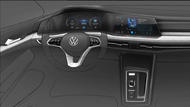Volkswagen’s eighth-generation Golf will get technology revamp with digital dashboard, but launch is delayed until 2020
Volkswagen has released an interior design sketch for the new Mk8 Golf, showing a distinct evolution of the brand’s cabin look and technology.
The image, which shows a thorough rethink of VW’s interior layout, reveals the Golf will adopt a large, dual-screen instrument and infotainment display panel stretched across the driver’s eyeline. The rest of the cabin gets a more minimalist look as a result.
Previous reports from Automotive News Europe stated that the family hatchback’s launch will be delayed until early 2020.
ANE quotes Volkswagen sales boss Jürgen Stackmann as saying: “We think it’s better to come early next year with a full throttle offensive. It doesn’t have anything to do with production. It’s a sales decision since you don’t try to put cars under the Christmas tree [ie put the car on sale in December] when no one is paying attention.”
VW had originally planned to launch the new Golf at the Frankfurt motor show. Instead Stackmann says the ID EV will be launched in Frankfurt. Stackmann also denied German media reports that the delay was a result of technical issues with the car’s digital dashboard and infotainment architecture.
A VW UK spokesman added that the delay was unlikely to impact UK deliveries significantly, as they were always scheduled for early 2020.
Surprisingly, the news comes not long after the new Golf was photographed undisguised during final testing.
The latest version of the Ford Focus rival has previously been spied without a camouflage livery, but the images – featuring several cars in a variety of colours – were the clearest yet. They showed how the eighth-generation version will maintain the familiar styling of the Golf, but that it will be sharpened and refined in line with the latest Volkswagen designs.
Volkswagen management have also begun offering some details about the latest version of the Golf, the most important machine in the firm’s range.
Speaking at the Geneva motor show, Stackmann said the new Golf maintained the heritage of previous versions, but with the benefits of new technology.
“The new Golf will be everything people loved for years, but now made digital,” said Stackmann. “People want a Golf – it’s iconic – but now there’s a huge leap forward in the digitisation inside it. It’s still a Golf, but now digital. It’s kept what people have loved and moved it to the next phase.”
Stackmann also confirmed there will be no e-Golf in the next generation to avoid overlap with the ID hatch and the range will instead “end with the GTE” in terms of electrification, with all future electric VWs based on the firm’s dedicated electric platform.
The GTI and R will be replaced, with the R again the range-topper. That means there will be no huge power boost for the hybrid GTE. Stackmann said there will be an announcement on the GTD, without confirming whether or not it will return.
The new Ford Focus rival was previously photographed by Volkswagen fan and Instagram user johannes.vag when it was passing through a McDonald’s drive-thru in Germany with virtually no protective camouflage.
The car in the shots tallies with last year’s official preview sketch and Autocar’s previous renderings, with a typically evolutionary design approach for the firm’s range mainstay and detailing adapted from the smaller Polo. A new grille and light design – previewed by the latest Touareg SUV – was hinted at in the sketch, but that family resemblance isn’t as evident in this prototype – likely because some trim pieces are still covered.
The Mk8 Golf will have levels of fuel-saving technology, connectivity, autonomous driving capability and refinement that are intended to render the mainstream competition second best.
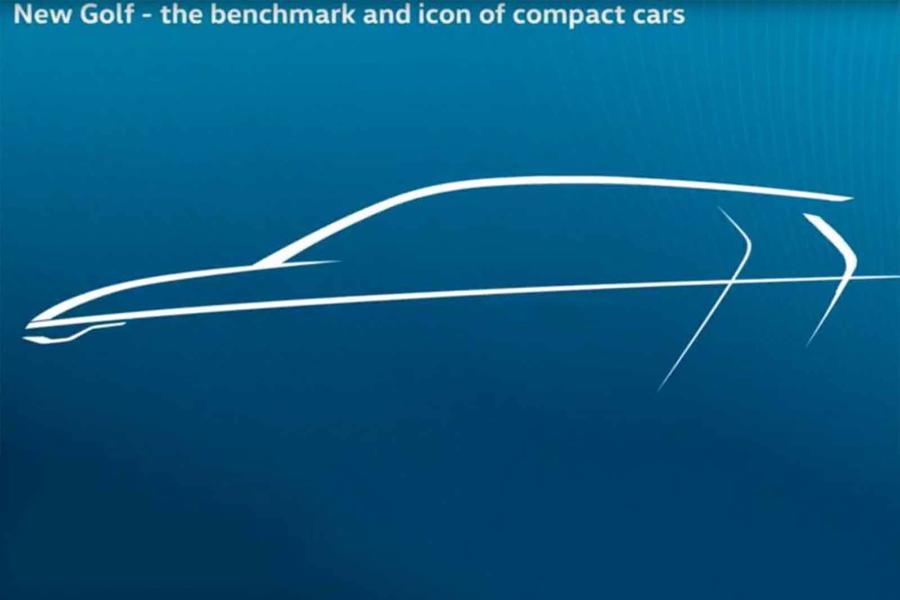
Its exterior styling will be an evolutionary design that again emphasises a wide, flowing C-pillar. There is expected to be a little more sharp-edged definition to the bodywork, following the template of the latest Polo. The GTI version will feature large corner air vents in its lower bumper, as previewed by the GTI TCR concept earlier this year.
Volkswagen will use the Mk8 Golf to introduce a powerful 48V mild-hybrid powertrain and a new range of micro-hybrids. There will also be versions powered by compressed natural gas, but there won’t be a new electric Golf, because Volkswagen will begin introducing its new ID range of electric cars shortly after the Mk8 is launched.
The model’s range will be simplified, with the three-door and estate bodystyles the most likely candidates for the axe. With consumers increasingly turning to SUVs and crossovers, and with makers of large mainstream cars under significant cost and profit pressures, insiders say the Golf Mk8 will attempt to lure buyers who are downsizing from larger cars and premium models such as the BMW 3 Series and Mercedes-Benz C-Class, offering more cabin and luggage space than is normal in this segment, outstanding refinement and exceptional fuel economy.
The new Golf will have a noticeably wider track and even more room in the already spacious cabin, as well as a marginally longer wheelbase and a bigger boot than its hatchback rivals.
The car is also expected to have an interior that’s almost completely devoid of conventional switches, at least on the higher-end models. Volkswagen design boss Klaus Bischoff has been quoted as saying that the Mk8’s interior is a “total” digital environment, with the steering wheel the only conventional component. Touchscreens will replace the traditional instrument binnacle and the climate controls. Even the headlight switch could be replaced by a touchpad.
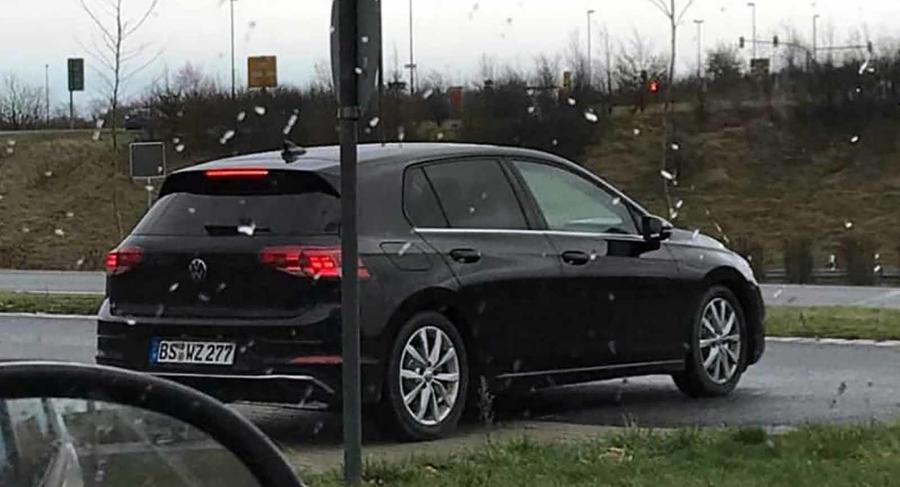
Update of Mk7 platform
The basis for the next Golf is an updated version of the versatile MQB platform used by today’s model. VW insiders suggest it will use a greater percentage of lightweight metal than the existing structure for a 50kg reduction in weight.
Planned modifications to the construction process are also said to provide more streamlined production and reduced build times as part of a strategy aimed at improving the economy of scale and profitability of VW’s best-selling model.
Although there is still some time to go before the new Golf’s introduction, VW says it has already locked in the car’s design, which has been developed under the guidance of the company’s latest design boss, Michael Mauer, who was responsible for the styling of the current Porsche line-up.
Those privy to the latest clay model mock-ups say the new Golf advances the classic hatchback look of its predecessors, with familiar proportions, reinterpreted details and simple surfacing to make it instantly recognisable as a Golf.
Key styling features described to Autocar include a thin horizontal grille bookmarked by smaller angular headlights than those in use today, with a distinctive LED daytime running light graphic. The new car is also said to have more pronounced wheel arches and a heavily defined side swage line, in combination with typically wide C-pillars and a relatively upright tailgate.
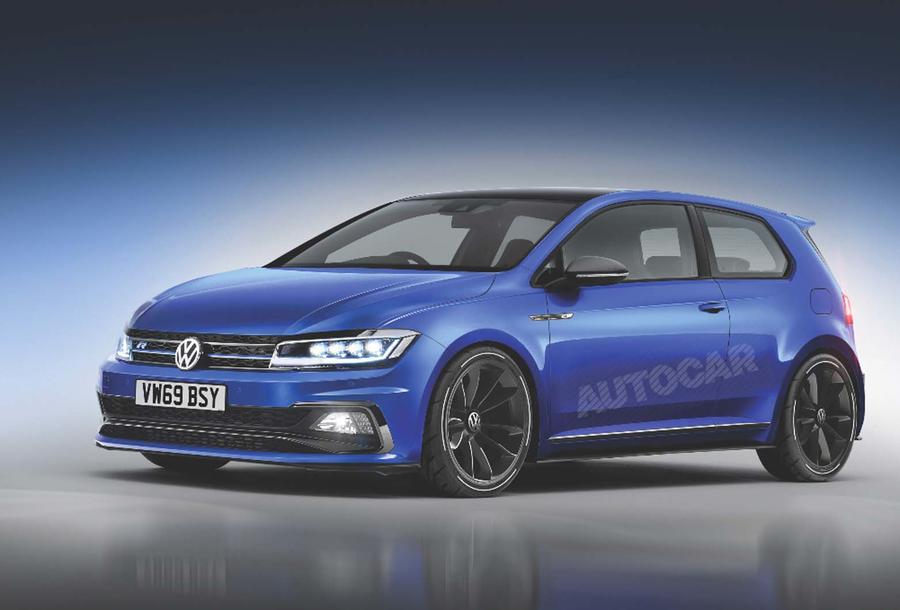
Petrol and diesel engines
The new Golf Mk8 will get a range of 12V mild-hybrid engines for the entry-level and mid-range variants. The 1.5-litre TSI ACT petrol unit will be carried over from today’s Golf Mk7 but this will be joined by a 1.0-litre three-cylinder petrol motor and an all-new 1.5-litre diesel, which is also likely to be sold as a 12V mild hybrid. Autocar understands that the assistance of the mild-hybrid system’s starter/ generator lessens the load on the engine and reduces the spikes of NOx emissions from the diesel’s exhaust.
One of the more intriguing rumours is that the 1.0-litre petrol engines might not be turbocharged at all, but could instead rely solely on direct assistance from a belt-driven starter/generator motor (SGM). The thinking is that the SGM will provide enough extra power and torque for the base engines, allowing the turbocharger, intercooler and associated piping and control systems to be dropped.
The Golf Mk8’s diesel line-up will include the new 2.0 TDI (codenamed EA288 Evo) engine. VW says the base version of this unit has been significantly re-engineered to reduce exhaust pollution. There is a more efficient and responsive turbocharger and the engine is lighter, loses less heat and has reduced internal friction.
More important, the engine’s particulate filter and catalyst have been resized for improved performance, particularly over time. VW claimed the engine offers an average of 9% more torque and power together with an average 10g/km decrease in CO2 emissions. The firm said the new diesel unit will come in versions ranging from 135bhp to 201bhp and will be seen in Audi models before being installed in the Golf Mk8 next year.
Crucial ID concept – click here for more
VW has already released details of the Golf’s 1.5-litre TGI Evo natural gas engine, production of which starts this year. Based on the 1.5-litre TSI engine, the TGI unit uses the same Miller cycle valve timing and a variable geometry turbocharger. It develops 129bhp and 148lb ft from 1400rpm when installed in the Golf Mk7. VW claims that this engine emits about 93g/km of CO2 on the NEDC cycle when it is hooked up to the standard- issue dual-clutch gearbox. Natural gas engines are also lower in NOx and particulate emissions than diesel and cars can be refilled from the gas mains network via small wall-mounted compressors. However, the lack of a natural gas infrastructure in the UK means this variant is unlikely to reach these shores.
The new or upgraded powertrains will be offered in combination with either a six-speed manual or seven-speed dual-clutch automatic gearbox, depending on their configuration. Alongside front-wheel drive, VW also plans to offer optional four-wheel drive (which it calls 4Motion) in selected models, like it has done in the previous four generations of its perennial best seller.
Two kinds of mild hybrid
The big surprise for the Golf Mk8 drivetrains is that VW says it will be investing in both 12V and 48V mild-hybrid systems after the company re-engineered the Golf family MQB electrical architecture (one of the more expensive component systems in a car) to accommodate a 48V system. Until now, 48V mild hybrids have only been used in premium VW Group cars such as the Bentley Bentayga and Audi SQ7.
Frank Welsch, VW’s technical development boss, has already revealed the firm’s new ‘affordable’ 48V system, which uses a belt-integrated starter/ generator/alternator to assist the engine by providing extra power and torque directly to the engine’s crankshaft.
The key to adopting 48V in a mass-market car was VW and its suppliers developing a less expensive and more compact set-up, which uses a small DC-to-DC converter and small lithium ion battery.
Welsch said the 48V set-up allows much greater amounts of energy to be recuperated than with 12V systems, which means significantly improved fuel economy. These new mild-hybrid engines can also start and stop extremely quickly, which will allow the Golf Mk8 to switch in and out of coasting mode when driving, making further fuel savings.
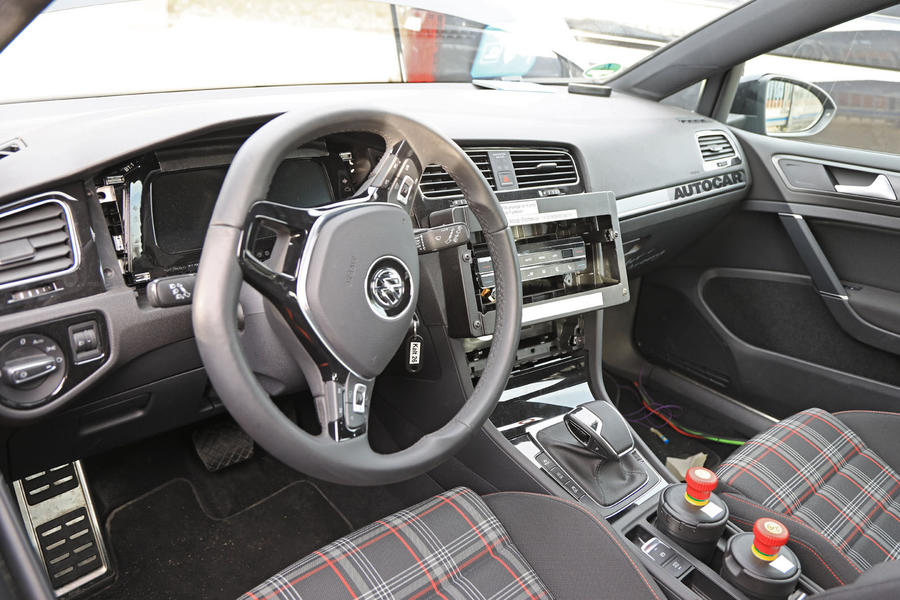
Connected tech takes precedence
VW sources have already promised that the next Golf will be ‘always connected’. Using the same eSIM card that has already appeared in the new Touareg, the Golf Mk8 will be permanently connected to the internet. This will allow the car to tap into 3D satellite mapping, hybrid radio (where the audio system finds the strongest signal for a station, whether analogue or digital) and the option of live information such as the latest pricing at nearby fuel stations.
The permanent connectivity opens the way for these future models to ‘read’ the topography of the road from 3D mapping, for example, and switch to coasting when heading downhill, or approaching a junction.
Autonomous driving will be a key feature of VW’s best-seller in its eighth generation, as the brand will shoehorn even more advanced autonomous technology into the new model, as well as ensuring that it is the most connected car in the company’s history, ahead of the all-electric ID hatchback that’s also due in late 2019.
Head of VW’s compact series, Karlheinz Hell, revealed: “The next Golf will take Volkswagen into the era of fully connected vehicles with extended autonomous driving functions. It will have more software on board than ever before. It will always be online and its digital cockpit and assistance systems will be the benchmark in terms of connectivity and safety.”
The current Golf benefits from VW’s semi-autonomous Traffic Jam Assist system, which controls the steering, acceleration and braking of the car under 37mph, so it’s certain that the Mk8 model will take a leap in advancement over this. Elsewhere, the Audi A8 is the first car in the wider VW Group to achieve level three autonomy where permitted.
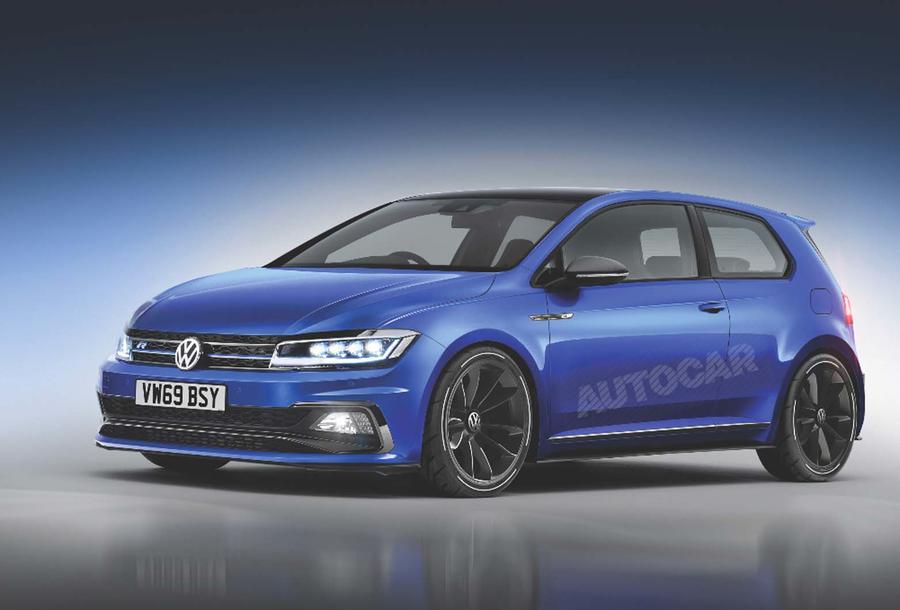
Golf to set VW design agenda
While the new Golf will be an evolutionary take on the outgoing car, it will feature new design elements that design chief Klaus Bischoff described being “more fluid, more sporty with a very unique face”.
It’s part of a new VW strategy to differentiate its standard model range from the new ID family of electric cars, said Bischoff: “[ID is] a new world of proportions and totally new bodystyles which are more emotional. As we go through the ceiling design- wise on ID cars, we need to echo that with ICE cars, so these will have more sporty proportions [and] a more progressive, clean design.”
Bischoff said future cars will remain faithful to VW’s traditional design cues: “We are looking to our origins so no ‘me too’ products. They will all remain as very individual VWs.
“If you look at front- of-car designs, nearly everybody is copying Audi. VW will go down its own road to stay true to the brand, and not look over the fence to others.”
Volkswagen reaps MQB’s rewards
Volkswagen’s MQB architecture underpins its best-selling model, the Golf, of which 968,284 were sold in 2017.
The modular toolkit is used for most of the firm’s most successful models. In total, five MQB models currently account for 3.8 million global sales.
The firm’s second-bestseller last year was the Jetta/Sagitar (the latter is a Chinese-market compact saloon), with 883,346 units sold. The seventh-generation Jetta, which went on sale this year, is now based on MQB, as are the firm’s two next best-sellers: the Tiguan SUV (769,870 sold), in both short- and long-wheelbase forms, and the Polo.
The Lavida, a Jetta-sized MQB saloon sold only in China, is the firm’s sixth best-selling model, with 507,000 made in 2017. That leaves the Passat/Magotan family, which is sold in Europe, the US and China. Current European versions of this model are built on MQB, with the US and Chinese versions switching to the architecture in 2019, adding another 660,000 or so MQB cars to the sales total.
Those figures are simply for Volkswagen itself: the MQB toolkit is also used widely across the group’s other brands.
Read more
Volkswagen Golf R power drops to 296bhp amid WLTP change
Volkswagen ID hatch to stay true to concept, says design boss
Source: Autocar
